Abstract
The influence of the bottle material (glass, PET), the reusability (reusable and disposable bottles), and the carbonization (still, medium, classic mineral water) on the filling ratio, packaging material use efficiency, cost, and shelf life were evaluated. Two hundred different bottles were purchased and characterized regarding their filling volume, the weight of the bottle, the weight of the closure, the weight of the label, and the maximum full-rim volume of the bottle. The packaging material use efficiency was calculated. The shelf life was evaluated by calculating the water vapor and carbon dioxide transmission rates. The ratio of filling volume to the packaging weight of disposable PET bottles was, on average, two times higher compared to returnable PET bottles and 20 times higher compared to glass bottles. Shelf life was, on average, higher than factor two for glass bottles compared to PET bottles. On average, but not in all cases, mineral water packaged in disposable PET bottles was cheaper compared to reusable PET and glass bottles. This paper provides a benchmark for the packaging community, especially when data for life cycle assessment are required, and the different advantages and disadvantages of different bottle materials for mineral water are shown.
1. Introduction
1.1. Mineral Water
In the European Union, “The laws of the Member States define natural mineral waters” [1]. Natural mineral water is defined in the German “Mineral- und Tafelwasser-Verordnung” as follows: “Natural mineral water is water that meets the following special requirements: 1. It originates in underground water deposits protected from contamination and is obtained from one or more natural or artificially developed springs […]” (direct translation from [2]); Mineral waters contain different minerals in different concentrations, depending on their origin [3,4,5,6,7,8,9,10,11,12,13]. Different studies found that mineral waters from German markets contained such natural ingredients and minerals as hydrogen carbonate, sulfate, and calcium, followed by sodium, chlorine, magnesium, and, to a lesser extent, potassium and fluorine, among many others (Figure 1) [8,9,10,11,12,13].
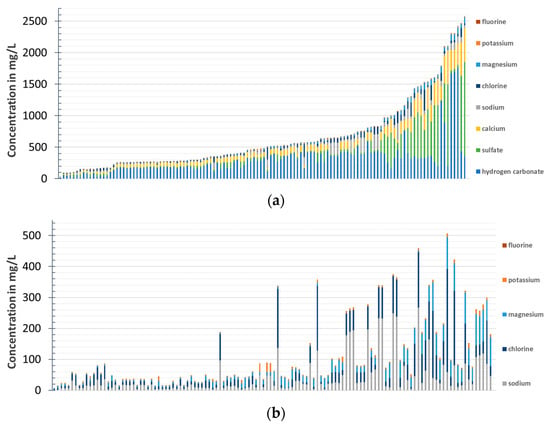
Figure 1.
(a) Concentrations of solved ingredients and minerals; (b) concentrations without hydrogencarbonate, sulfate, and calcium; data from Germany [14,15,16,17]; X-axis with ordered samples of the references.
The list of natural mineral waters in the Federal Republic of Germany comprises 825 mineral waters, reported in March 2022 [18] (in this study, no distinction was made between mineral water and spring water). In 2022, 157 businesses were active in this area in the German market. Each German consumed around 129.5 L of mineral and curative waters per year, and sales of mineral and curative waters amounted to around 10,120.5 million liters. Packaging used is reusable glass packaging (21%), reusable PET packaging (14%), PETCYCLE (5%), disposable (single use) PET packaging (60%), and other packaging (<1%) [19]. PET has substituted glass due to its lower weight, stability, and transparency [20]. A PET bottle is seen as a “lightweight, safe and cost-effective container, being at the same time recyclable” [21].
Mineral water contains natural CO2, and CO2 is added artificially. Modern filling technology enables a CO2 concentration of up to 12 g/L. To prevent the bottles from bursting, the concentration is restricted to 8 g/L [3]. The CO2 concentrations in mineral water differ. The mineral water company Gerolsteiner Brunnen GmbH & Co. KG (Gerolstein, Germany) reports a CO2 concentration of 7 g/L for its mineral water “Gerolsteiner Sprudel”. The author of this study, Müller, reported a CO2 concentration of 7.5 g/L [22]. Liger-Belair differentiated between low-carbonated water with a CO2 concentration of 3.3 ± 0.1 g/L, medium-carbonated water with a CO2 concentration of 4.5 ± 0.2 g/L, and highly carbonated water with a CO2 concentration of 6.9 ± 0.3 g/L [23,24]. The German test and consumer magazine “Stiftung Warentest” tested different mineral waters from consumer markets. Still mineral water (“stilles Wasser”) had a CO2 concentration of 0.02 ± 0.2 g/L [16], medium mineral water had a CO2 concentration of 3.7 ± 0.6 g/L [15] and 3.8 ± 0.7 g/L [14], and classic mineral water had a CO2 concentration of 5.4 ± 0.8 g/L [17]. Folz gave a correlation between solved CO2 and pressure for beer [25]: CO2 concentrations of 3.7 and 5.4 g/L would correspond with these values with 2.2 and 3.4 bar pressures at 20 °C and 4 and 5.7 bar pressures at 40 °C. A higher CO2 concentration causes, therefore, a higher pressure in the bottles. At 30 °C with 1 bar and 5 bar CO2 pressures, 1.3 g and 6.3 g CO2 are solved in 1 L of water [26]. At 25 °C and 1 bar CO2 pressure, 1.5 g CO2 is solved in 1 L of water [27]. At 20 °C, 1 bar CO2 pressure of the CO2 solubility is 1.72 g/L [28]. Herwig reported slightly lower values [29]. At 20 °C and 3 bar CO2 pressure, approximately 5 g/L is solved [29]. The CO2 solubility reduces with increasing temperature, and it reduces with increasing concentration of solved minerals [26,27,28].A higher CO2 concentration correlates with a lower pH value (Figure 2, data from [14,15,16,17]). Furthermore, the pH value correlates with the solved minerals in the water, especially hydrogen carbonate. With a lower hydrogen carbonate concentration, the pH value reduces. Hydrogen carbonate reduces the acidic effect of carbon dioxide (see for lime-carbonic acid equilibrium) [30,31]. Rosborg reported the pH values of mineral water between 4.42 and 8.29 [5]. Bertoldi reported the pH values between 3.66 and 9.28 [8], and Birke reported the pH values between 3.8 and 8.1 for German waters [10]. German tap water had a pH value of 6.84 to 8.63 [10]. In the literature, some discussion can be found about the increased leaching of antimony from PET influenced by the pH value of water. However, there is a low to no effect [32].
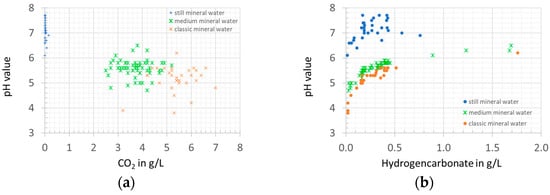
Figure 2.
Correlation of solved CO2 (a) and solved hydrogen carbonate (b), with pH values; data from Germany [14,15,16,17].
1.2. PET and Glass Bottles
Consumption of bottled mineral water increased. One reason is that consumers consider bottled water as safe [6]. An Italian study found that “the perception of poor quality of tap water appeared to be decisive in the choice of consumers regarding the type of drinking water” [33].
PET bottles are processed by injection blow molding [20,34,35,36,37]. With an increasing stretch ratio of the preform, the filling volume increases, and the bottle wall thickness reduces [36]. PET bottles are disposable (single-use) or returnable (multi-use) PET bottles. PET bottles are often recycled into new PET bottles with direct food contact [38]. Bottle-to-bottle recycling has been established in Europe for many years and is considered a safe process [39,40].
Glass bottles are produced by the “blow and blow” process [41]. Glass has a higher density of 2.5 g/cm3 (soda–lime glass) [42] than PET with a density of 1.37 g/cm3 [43]. Glass is brittle; therefore, the wall thicknesses of glass bottles must be higher compared to PET bottles. A higher wall thickness is associated with higher impact resistance [44]. However, several developments in the last decades have aimed to reduce the glass-packaging weight, e.g., by various process optimization and surface treatments [41,45,46]. Consumers perceive glass packaging as more pleasant [47]. In glass bottles compared to PET bottles, a lower CO2 loss during storage was observed [37].
A relevant number, besides the transport distance, is the circulation number for reusable bottles. Different studies from non-peer review studies and market studies reported circulation numbers of up to roughly 50 for reusable (returnable) glass bottles and up to roughly 25 for reusable PET bottles [48,49]. However, these numbers were based on information from the industry, and estimations are, therefore, associated with some uncertainties and discussion. In other studies, a circulation number for reusable glass bottles of 6 [50], 25 [51], and 30 was assumed [52] before the end of life. The company Adelholzener Alpenquellen GmbH (Siegsdorf, Germany) claims that its reusable PET bottles can be refilled up to 15 times, and its reusable glass bottles approximately 40 times.
1.3. Intention of This Study and Hypotheses
The aim of this empirical market study was to gain a better understanding of the packaging situation for bottled mineral water. Such learnings are useful for finding improvements, and these provide a benchmark for the packaging community. Our main hypotheses were as follows: (1) the material use efficiency increases with a higher filling quantity; (2) reusable bottles are heavier than disposable bottles at the same filling quantity; (3) PET bottles made of recycled PET are heavier than when made of virgin PET; and (4) PET bottles for carbonated water are lighter than PET bottles for non-carbonated water because bottle stabilization by CO2 pressure is possible.
2. Materials and Methods
2.1. Sampling
Samples were purchased from September 2022 to January 2023 in the Munich area from German supermarkets (“Aldi”, “Rewe”, “Orterer Getränkemärkte”, “Lidl”, “Edeka”, “Penny”, “AEZ”, “AsiaMarktCity”), drugstores (“dm”, “Müller”), and organic stores (“VitaSinn”, “Landmann’s Biomarkt”), and in addition, 23 bottles were purchased in an Austrian supermarket (“Spar”). Only mineral water was purchased. Flavored mineral water was excluded. The number of samples was 200 (92 from German supermarkets, 23 from Austrian supermarkets, 63 from the beverage markets, 11 from drugstores, 10 from organic stores, and one from an Asian market). Some analyzed bottles are shown in Figure 3. All acquired glass bottles were reusable glass bottles. The raw data can be found in the Supplementary Materials (Measured_Data).
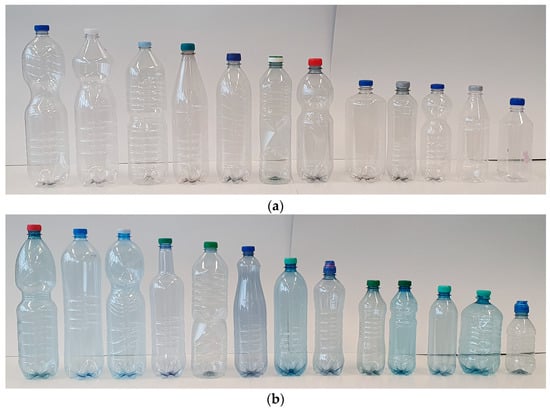
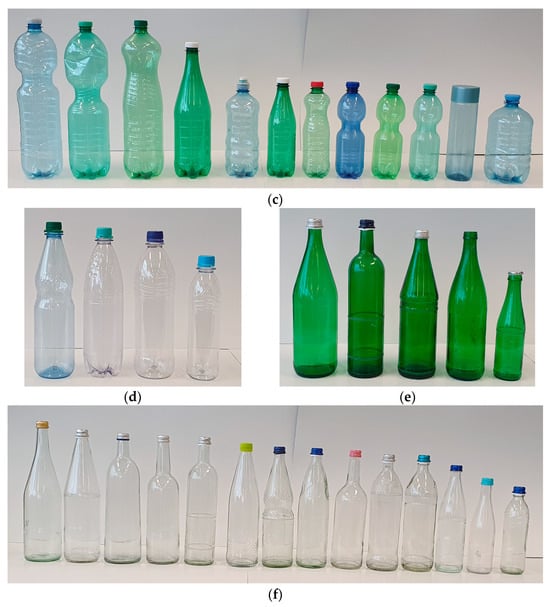
Figure 3.
Examples of analyzed bottles: (a–c) disposable PET bottles; (d) reusable PET bottles; (e,f) reusable glass bottles.
Further data about the weights of disposable and reusable glass bottles were purchased from the company Vetropack Holding Ltd. (Bülach, Switzerland, https://www.vetropack.com (accessed on 30 May 2023)).
2.2. Categorization
The products were classified for analysis as follows: category: carbonated and non-carbonated mineral water; packaging: PET bottle (n = 148), glass bottle (n = 51); materials: virgin PET (n = 70), rPET (n = 78; n = 2 with 30% rPET, n = 17 with 50% rPET, n = 59 with 100% rPET), glass (n = 51); closures: aluminum (glass bottles), plastic (PET bottles; n = 135 screw caps; n = 9 drink closures; n = 5 tethered caps); label category: plastic label (n = 127) PET bottles, paper label (all glass bottles; n = 21 in PET bottles), shrink sleeve (n = 20 in PET bottles); optical properties of bottles: transparent (n = 80 in PET; n = 46 in glass), blue (n = 57 in PET), green (n = 11 in PET; n = 5 in glass), white; disposal information (if any): all disposal information, post-consumer recycling system, deposit information, no disposal information.
2.3. Sample Preparation and Measuring of Weights
The bottles were emptied completely and dried for a few days at approximately 20 °C and approximately 50% RH. The following product information was taken from the receipt, ingredient list, and imprint on the bottle: product name; product type; brand; store; filling volume; cost; deposit; expiration date (shelf life); and date of purchase. The measured characteristics were the following: weight of the bottle with cap and label; weight of the bottle without closure and label; weight of the closure; weight of the label; and the maximum full rim volume of the bottle.
To determine the full rim volume, each empty bottle was placed on the scale, and the scale was tared. Then, the bottle was filled up to the top with tap water using a measuring cup so that the water surface was flush with the rim of the bottle. The measured weight of the filled bottle corresponded to the full rim volume. It was assumed that tap water had a density of 1 g/cm3 and a temperature of approximately 20 °C. The measured weight was equal to the volume, and the full rim volume could then be expressed in mL or g.
The weight of the bottles, the closure, and the label were measured with a precision balance (model Radwag WTB 2000, Radwag Waagen GmbH, Hilden, Germany; weighing capacity of 2000 g and an accuracy of 0.01 g).
3. Results and Discussion
3.1. Packaging Efficiency
3.1.1. Filling Ratio
The filling ratio was calculated from the nominal filling volume (printed on the label) and the measured full rim volume. This value was a measure of how well the bottles were filled. For simplification, the density of the water was assumed to be 1 g/cm3. A filling ratio of one means that the filling volume is equal to the full rim volume. The filling volume was lower than the full rim volume, as expected. The difference was the headspace volume. The filling ratio varied between 0.90 and 0.99 mL/mL (Figure 4). However, there were small differences in the bottle types. The glass bottles had a filling ratio of between 0.94 and 0.97 mL/mL with a mean value of 0.96 mL/mL. It increased with increasing filling volumes. The filling ratio for PET bottles varied more than for glass bottles, from 0.90 to 0.99 mL/mL, with a mean value of 0.95 mL/mL. In reusable PET bottles, the filling ratio was, on average, higher than in disposable PET bottles. A possible reason for these differences was the higher water vapor transmission rates of disposable PET bottles. The following calculation should explain the difference:
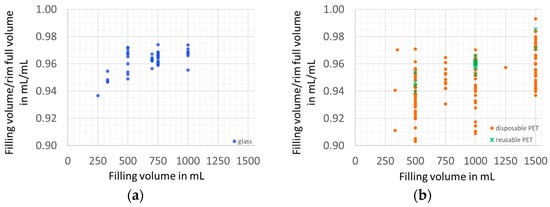
Figure 4.
Filling ratios: (a) glass bottles (reusable); (b) PET bottles; assumed density of fill product 1 g/cm3.
A 500 mL disposable PET bottle with a weight of 15 g has a surface area of about 0.04 m2 and a mean thickness of about 270 µm. Assuming a water vapor permeability of at 23 °C and 85% rh [53,54] and a mean relative humidity of 50% in the store, the daily loss of water will be
After half a year, the water loss caused by permeation will be 4.7 mL in a 500 mL bottle. In praxis, the water loss can be even higher since the wall thickness is not homogeneous. The weight and, therefore, the wall thickness of the reusable PET are two to four times higher (see Section 3.1.2), and therefore, the water loss is two to four times higher in disposable PET bottles compared to reusable PET bottles. Although glass is impermeable to water, a low amount of water can be lost by water vapor permeation through the cap. This was obvious and was confirmed by others [55].
The pre-packaging regulation (76/211/EEC) fixes the tolerable negative deviation in the contents of a pre-package. For example, the tolerable negative deviation for a 500 mL bottle is 15 mL. When, in this example, the loss of water is 4.7 mL in half a year, the distributor has to ensure that the tolerable volume should not go below a limit of 485 mL. With an initial filling volume of 500 mL, the critical value of 485 mL will be reached after 1.5 years. In consequence, the bottles have to be overfilled, or the shelf life has to be reduced.
These results also showed that in PET bottles, the most often used filling quantities were 1500 mL (n = 48), 1000 mL (n = 40), and 500 mL (n = 45). In glass bottles, the filling quantities were 750 mL (n = 19), 700 mL (n = 10), and 500 mL (n = 10). The German test and consumer magazine “Stiftung Warentest” reported filling quantities for disposable PET bottles of 2 L (n = 1), 1.5 L (n = 45), 1.25 L (n = 2), 1 L (n = 10), 0.75 L (n = 2), and 0.5 (n = 3); for reusable PET bottles, of 1 L (n = 28) and 0.75 L (n = 2); and for glass reusable bottles, of 0.7 L (n = 12), 0.75 L (n = 12) and 1 L (n = 1) [14,15,16,17]. Obviously, filling quantities of 1.5 L in disposable PET bottles, 1 L in reusable bottles, and around 0.7 L in reusable glass bottles dominated as filling quantities, which were similar to the results of this study.
3.1.2. Packaging Material Use Efficiency
With increasing filling volumes, the bottle weights increased, as expected (Figure 5 and Figure 6) [49,56,57]. In glass bottles above a filling volume of 750 mL and in PET bottles above a filling volume of 1000 mL, the bottle weight did not increase further. Glass bottles were roughly by the power of ten heavier than PET bottles, which has already been known [49,51,57].
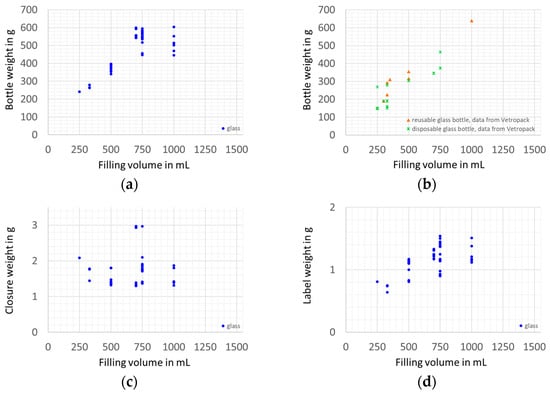
Figure 5.
Packaging weights of glass bottles: (a) glass bottles (all reusable); (b) glass bottles; data from Vetropack; (c) closure (aluminum screw caps); (d) labels (paper).
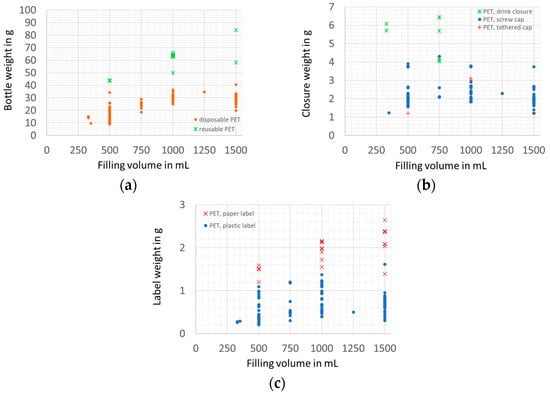
Figure 6.
Packaging weights of PET bottles: (a) PET bottles; (b) closures (plastic screw caps); (c) labels (paper or plastic).
The bottle weight at fixed filling volumes was scattered in some cases by a factor > 2. This finding is meaningful since, for LCA and PEF calculations, the bottle weights are relevant. The choice of a lighter bottle reduces the environmental impact of the packaging. In PET bottles, higher weights were observed in reusable bottles that were roughly two to four times heavier than disposable single-use bottles (the analyzed glass bottles were all reusable bottles, and therefore, single-use and multi-use bottles cannot be compared). However, published data from the company Vetropack indicated that reusable glass bottles had a small tendency to be heavier than disposable glass bottles. The scattering of weights of disposable glass and PET bottles with the same filling volumes was caused by differences in design and in PET bottles, by different wall thicknesses. Interestingly, the preform suppliers of PET bottles offer the same preform for different PET bottle weights. Figure 7 depicts the minimum and maximum filling volumes for single preforms. It is obvious that preforms could be blown with a higher ratio, resulting in an increased filling volume, but the wall thickness would be lower then.
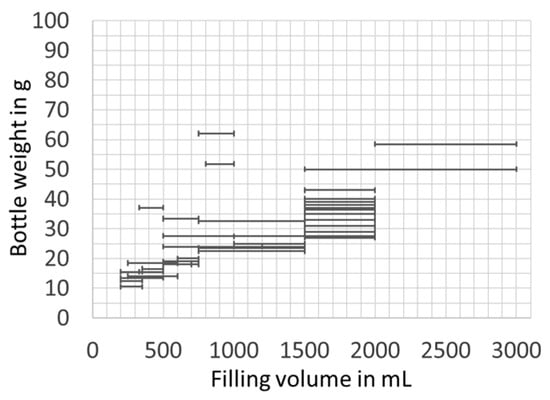
Figure 7.
Possible PET bottle weights made of preforms with same weight; data from Jesper PET Preform Corporation, Hsinchu City 300, Taiwan (n = 28), and Petainer UK Holdings Limited, London, UK (n = 55).
In glass bottles, only aluminum caps were found with a weight between one and three grams. In PET bottles, plastic closures were used with a weight of one to almost seven grams. Drink closures were especially heavy, with a weight of four to seven grams. All other closures, except one, were lighter, with a typical weight of two grams. For the closure weights, no correlation with the filling volume was found.
The label weights were also much lower than the bottle weights, with a weight of 0.5 to 2.5 g per label. In glass bottles where paper labels were used, the label weight correlated positively with a bigger filling volume. In PET bottles, such correlation was also found in paper labels but not in plastic labels. Interestingly, the plastic labels were slightly lighter than the paper labels. Go found similar results in his study, also for PET bottles and closure weights [58].
The packaging material use efficiency was calculated from the nominal filling volume divided by the packaging weight (Figure 8). It is a measure of how much packaging material is required for a volume unit of filling. The packaging efficiency of glass bottles had values between 1 and 2.2 g of water/g packaging material, in reusable PET bottles, between ten and 24 water/g of packaging material, and in disposable PET bottles, between 10 and 70 g of water/g of packaging material (the packaging efficiency included the weight of the label and of the closure). Hence, packaging water in PET bottles required less packaging weight. It is important to keep in mind that glass bottles can be reused roughly up to 50 times and reusable PET bottles up to 25 times, as mentioned before [48,49]. Therefore, the packaging material use efficiency of reusable bottles is higher due to these factors before these bottles are no longer refilled.
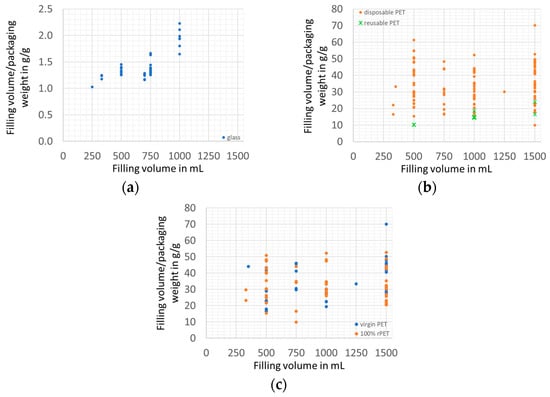
Figure 8.
Packaging material use efficiency of bottles including closure and label: (a) glass bottles (reusable); (b) disposable versus reusable PET bottles; (c) disposable PET bottles made of virgin PET vs. 100% recyclable PET.
The efficiency increased with a higher filling volume of glass bottles. In PET bottles, such increased efficiency with higher filling volume could be derived from the results, with the exception of reusable PET bottles. In PET bottles, the efficiency is highly scattered for one filling volume, which is explained by the packaging design, especially the wall thickness of the bottles. The low efficiency can be explained by higher medium wall thickness and, therefore, a stiffer bottle. The up to factor six higher efficiency of disposable PET bottles compared to reusable PET bottles is striking. Reusable bottles must be more stable, which explains the higher required bottle-wall thickness that reduces the packaging efficiency. However, as mentioned before, reusable PET bottles can be reused up to 25 times. Therefore, the packaging material use efficiency considering multiple uses is higher by up to this factor before these bottles are disposed of for recycling.
In Figure 8c, the packaging efficiency is compared for PET bottles made of virgin PET and 100% recycled PET (rPET). No differences in the packaging efficiencies can be seen. Even though the mechanical properties were not tested, this result allowed for the conclusion that virgin PET substitutes rPET with no deviations in bottle weight. This result was on the first view paradox. Several studies reported that the mechanical properties of PET are reduced by chain scission, e.g., due to hydrolysis and oxidation, causing lower strain, lower viscosity, and lower tensile strength [59,60,61,62,63]. However, recycling technologies have improved in recent years. PET properties can be improved. For recycling, PET is dried and processed in a vacuum and/or nitrogen, and the molecular weight (chain length) is increased by solid-state polycondensation (SSP) [63,64,65,66,67,68,69,70,71,72]. Moreover, SSP supports the decontamination of PET [38,73].
3.2. Shelf Life
Commercial mineral water differs in its CO2 concentration, and the water is divided into “natural” (low CO2 concentration), “medium” (medium CO2 concentration), and “classic” (highest CO2 concentration). The packaging efficiency, here referring only to the bottle weight, was in the same range for these three CO2-concentration categories (Figure 9). Non-carbonated and carbonated water were, therefore, poured into PET bottles with similar weights (in the literature, it was reported that PET for carbonated drinks required a higher intrinsic viscosity and, thus, a higher molecular weight [64,74]). Our hypothesis that PET bottles for carbonated water would be lighter than PET bottles for non-carbonated water because of bottle stabilization by CO2 pressure was not true and was falsified. However, the shelf life of carbonated water was limited by the CO2 transmission rate. CO2 loss through PET bottles is a known phenomenon [37]. The following calculation refers to a 15 g PET bottle with a filling volume of 500 mL and a CO2 permeability of at 23 °C (compare with [75]). The CO2 pressure in a medium CO2 concentration bottle is about 2 bar, and therefore, the CO2 loss amounts to
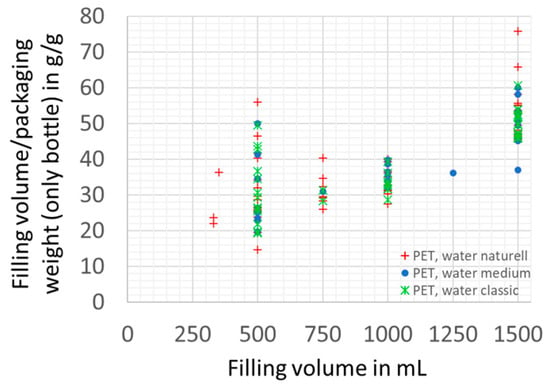
Figure 9.
Packaging efficiencies of bottles (without closure and label) at different qualitatively described CO2 concentrations.
After half a year, the CO2 loss caused by permeation through the bottle wall (without closure) will be 0.64 g in a 500 mL bottle, or 1.28 g/L. Thus, the initial CO2 content of medium-carbonated water is reduced from 4.5 g/L to 3.2 g/L. Consequently, the water vapor loss, as well as the decrease in CO2 content, limited the shelf life of mineral water bottled in disposable PET bottles. The effect was stronger for PET bottles with a thin wall thickness.
The maximum remaining shelf life after buying was observed in glass bottles (Figure 10). In glass and PET bottles, shelf life was longer in “medium-carbonated water”. An obvious explanation is the loss of CO2 in carbonated water that permeated into the environment through the PET wall and, to a lesser extent, through the closure [76]. However, CO2 loss also occurred in smaller amounts through the closure of glass bottles. In this context, it was plausible that the shelf life should be shorter in PET bottles. Furthermore, water loss restricts shelf life, as was explained before. In PET bottles, the migration of non-intentional substances could restrict the shelf life, which can deteriorate sensory quality [77]. Also, the migration of acetaldehyde, which results in a fruity taste, may occur, which is better noticed in water than in flavored beverages [3,6,20,76,78,79,80,81]. Migration of acetaldehyde could be prevented by using an acetaldehyde scavenger in PET [78,82]. Also, other substances other than acetaldehyde could cause sensory changes described as “medicinal off-flavor” and “sunlight flavor” [6,83,84,85]. It is worth mentioning that low amounts of elements can also leach from glass bottles [86]. Increased leaching was observed at lower pH values [86].
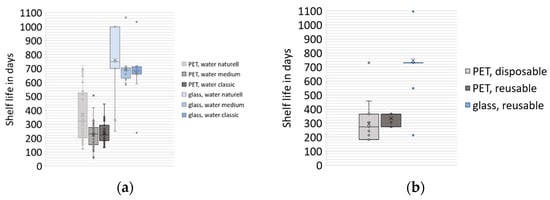
Figure 10.
Shelf life of mineral water in bottles made of PET and glass: (a) on day of buying; (b) from published data [14,15,16,17].
3.3. Cost
Water packaged in glass bottles was more expensive than in PET bottles (Figure 11). An explanation could be that a higher bottle weight correlated with a higher perceived value. Such a correlation was found by Soares et al. in wine [87]. Water in PET bottles tended to be cheaper with increasing filling volume. Such an effect was also observed in yogurt [57]. The lowest cost was observed in water in disposable PET bottles from a German discounter at 0.17 €/L. Similar results were found in the test magazine “Stiftung Warentest” [17]. The lowest previous costs reported there in 2020 were 0.13 €/L. German tap water, which has the quality of drinking water, costs much less, with 0.00385 €/L (reported in 2019) [88] and approximately 0.005 €/L (reported in 2016, including wastewater costs) [89]. When comparing disposable and returnable PET bottles in Figure 11c, water in disposable PET bottles is, by trend, cheaper. However, the variance is higher since there are also relatively expensive brands of water in disposable PET bottles.
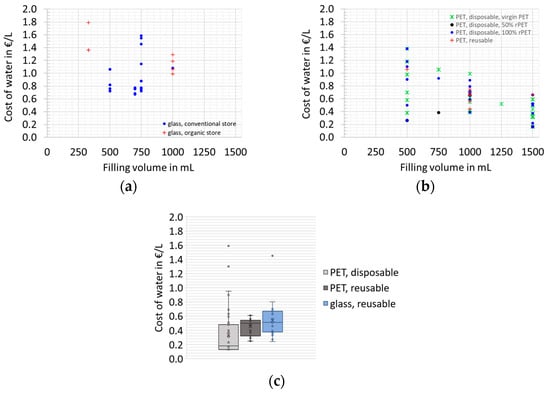
Figure 11.
Cost of water, comparison of (a) glass (reusable) and (b) PET bottles; PET bottles without bottles with drink caps; (c) from published data [14,15,16,17].
4. Conclusions
The filling ratio is an important packaging functionality of PET and glass bottles for mineral water. In this context, the filling ratio was calculated as a quotient from the nominal filling volume and the measured full rim volume. The filling ratio of glass bottles and reusable PET bottles had the same mean value of 96%, whereas the filling ratio of disposable PET bottles varied more with a lower average. A possible reason for these differences is the higher water vapor transmission rates of disposable PET bottles caused by thinner wall thickness. In order to avoid an undercut of the tolerable negative deviation in the content of bottles, disposable bottles have to be overfilled or shelf life has to be reduced. For expensive filling goods, overfilling might be a cost problem; however, in the case of mineral water, the costs of the packaging material and the filling process are higher than those of the filled water. Therefore, the costs of overfilling mineral water are not critical.
The bottle weights for the same filling quantities differ in many cases by factor > 2. For years, there has been a trend to lighter bottle weights. When reducing the bottle weight, (a) the material cost could be reduced significantly, and (b) the environmental influence of the packaging material would be strongly reduced. However, the downgauging of material thickness is restricted by the limitation of mechanical stability. Disposable PET bottles with very low packaging weight need a higher internal pressure caused, for example, by carbonation. The bottler has to find a compromise between the material/cost saving and the mechanical handling of the bottles.
In this context, the material use efficiency as the ratio of filling volume to packaging weight is the highest for disposable PET bottles and would be, in the first view, the best choice. However, these factors have to be relativized because the glass bottles for mineral water are refilled up to 50 times and the reusable PET bottles up to 25 times. The decision for glass or PET, on the one hand, and reusable or disposable bottles, on the other hand, is not only driven by the bottling industry. In fact, this decision has to be made depending on customer requirements (discounter vs. beverage retailer) and legislation (EU Waste Framework Directive).
The results of this study showed that water in disposable PET bottles tended to be cheaper with increasing filling volume compared to other bottle types. The lowest costs were observed at a discounter that offered water in disposable PET bottles for 0.13 (in 2020) and 0.17 €/L (in 2022). Such low costs have to be avoided from the industrial perspective and can only be explained by the market power of German discounters since these dumping prices are only somewhat above the material and filling costs.
Technically speaking, there are further aspects that are relevant to the evaluation of the packaging material use efficiency like the CO2 emission caused by the transport roadway for different bottle types or by the bottle washing machine for the returnable bottles. However, a life-cycle analysis is beyond the scope of this paper and should be addressed by another research.
Supplementary Materials
The following supporting information can be downloaded at https://www.mdpi.com/article/10.3390/beverages10020025/s1, Table S1: Measured_Data.
Author Contributions
Conceptualization, S.S.; methodology, A.G. and S.S.; validation, A.G., S.S. and K.M.; formal analysis, A.G.; investigation, A.G.; resources, S.S.; data curation, A.G. and S.S.; writing—original draft preparation, S.S. and A.G.; writing—review and editing, K.M. and S.S.; visualization, A.G. and S.S.; supervision, S.S.; project administration, S.S.; funding acquisition, S.S. All authors have read and agreed to the published version of this manuscript.
Funding
This work was financially supported by the Munich University of Applied Sciences HM and the Deutsche Forschungsgemeinschaft (DFG, German Research Foundation)—Project number 512819356.
Data Availability Statement
The datasets used during the current study are available from the corresponding author upon reasonable request.
Acknowledgments
We thank Rainer Nerlich from Munich University of Applied Sciences HM for supporting the publication process and Cihat Yilmaz from Munich University of Applied Sciences HM for providing data.
Conflicts of Interest
The authors declare no conflicts of interest.
References
- Directive 2009/54/EC of the European Parliament and of the Council of 18 June 2009 on the Exploitation and Marketing of Natural Mineral Waters (Recast) (Text with EEA Relevance): 2009/54/EC, 2009. Available online: https://eur-lex.europa.eu/LexUriServ/LexUriServ.do?uri=OJ:L:2009:164:0045:0058:EN:PDF (accessed on 30 May 2023).
- Verordnung über Natürliches Mineralwasser, Quellwasser und Tafelwasser (Mineral- und Tafelwasser-Verordnung): Min/TafelWV, 1984. Available online: https://www.gesetze-im-internet.de/min_tafelwv/BJNR010360984.html (accessed on 30 May 2023).
- Matissek, R. Erfrischungsgetränke. In Lebensmittelchemie, 9th ed.; Matissek, R., Ed.; Springer Spektrum: Berlin, Heidelberg, 2019; pp. 853–857. ISBN 978-3-662-59668-5. [Google Scholar]
- Belitz, H.-D.; Grosch, W.; Schieberle, P. Lehrbuch der Lebensmittelchemie, 6th ed.; Springer: Berlin, Heidelberg, 2008; ISBN 9783540732013. [Google Scholar]
- Rosborg, I.; Nihlgård, B.; Gerhardsson, L.; Gernersson, M.-L.; Ohlin, R.; Olsson, T. Concentrations of inorganic elements in bottled waters on the Swedish market. Environ. Geochem. Health 2005, 27, 217–227. [Google Scholar] [CrossRef] [PubMed]
- Marcussen, H.; Holm, P.E.; Hansen, H.C. Composition, Flavor, Chemical Foodsafety, and Consumer Preferences of Bottled Water. Compr. Rev. Food Sci. Food Saf. 2013, 12, 333–352. [Google Scholar] [CrossRef] [PubMed]
- Kończyk, J.; Muntean, E.; Gega, J.; Frymus, A.; Michalski, R. Major inorganic anions and cations in selected European bottled waters. J. Geochem. Explor. 2019, 197, 27–36. [Google Scholar] [CrossRef]
- Bertoldi, D.; Bontempo, L.; Larcher, R.; Nicolini, G.; Voerkelius, S.; Lorenz, G.D.; Ueckermann, H.; Froeschl, H.; Baxter, M.J.; Hoogewerff, J.; et al. Survey of the chemical composition of 571 European bottled mineral waters. J. Food Compos. Anal. 2011, 24, 376–385. [Google Scholar] [CrossRef]
- Cicchella, D.; Albanese, S.; Vivo, B.d.; Dinelli, E.; Giaccio, L.; Lima, A.; Valera, P. Trace elements and ions in Italian bottled mineral waters: Identification of anomalous values and human health related effects. J. Geochem. Explor. 2010, 107, 336–349. [Google Scholar] [CrossRef]
- Birke, M.; Rauch, U.; Harazim, B.; Lorenz, H.; Glatte, W. Major and trace elements in German bottled water, their regional distribution, and accordance with national and international standards. J. Geochem. Explor. 2010, 107, 245–271. [Google Scholar] [CrossRef]
- Lyubomirova, V.; Mihaylova, V.; Djingova, R. Chemical characterization of Bulgarian bottled mineral waters. J. Food Compos. Anal. 2020, 93, 103595. [Google Scholar] [CrossRef]
- Dinelli, E.; Lima, A.; Albanese, S.; Birke, M.; Cicchella, D.; Giaccio, L.; Valera, P.; Vivo, B.d. Comparative study between bottled mineral and tap water in Italy. J. Geochem. Explor. 2012, 112, 368–389. [Google Scholar] [CrossRef]
- Roje, V.; Šutalo, P. Trace and major elements in Croatian bottled waters. J. Geochem. Explor. 2019, 201, 79–87. [Google Scholar] [CrossRef]
- Hoch die Flaschen: Mineralwasser. Stiftung Warentest. July 2023. 12–19. Available online: https://www.test.de/shop/test-hefte/test_07_2023/ (accessed on 31 October 2023).
- Mineral Was? Mineralwasser: Die Beliebteste Mineralwasser-Sorte ist Medium. Erfrischend ist auch das Testergebnis: 27 von 31 Medium-Wässern Sind Sehr Gut Oder Gut. Stiftung Warentest [Online], August 2020, 10–17. Available online: https://www.test.de/shop/test-hefte/test_08_2020/ (accessed on 30 May 2023).
- Von Sehr Gut Bis Entzaubert, Mineralwasser: Viele der 32 Stillen Wässer Sind Sehr Gut Oder Gut. Zwei der Fünf Bioprodukte im Test Gehören Nicht Dazu. Auch Enttäuschend: Die Edelmarken Voss und Healsi. Sie Sind Vor Allem Eins–Besonders Teuer. Stiftung Warentest [Online], August 2021, 10–17. Available online: https://www.test.de/shop/test-hefte/test_08_2021/ (accessed on 30 May 2023).
- Top-Wässer ab 17 Cent pro Liter, Mineralwasser: In unserem Test von 32 Classic-Mineralwässern Machen vor Allem Preiswerte von Sich Reden. Zwei Markenwässer Dagegen Versprechen zu viel. Eins fällt Geschmacklich Negativ auf. Stiftung Warentest [Online], July 2022, 12–19. Available online: https://www.test.de/shop/test-hefte/test_07_2022/ (accessed on 30 May 2023).
- Dross. Liste der in Deutschland Amtlich Anerkannten Natürlichen Mineralwässer aus Deutschland. 2022. Available online: https://www.bvl.bund.de/SharedDocs/Downloads/01_Lebensmittel/datenmanagement/mineralwasser_deutsche.html (accessed on 30 May 2023).
- VDM Verband Deutscher Mineralbrunnen e.V. Vorläufige Branchendaten 2022, 2023. Available online: http://www.vdm-bonn.de; https://www.mineralwasser.com (accessed on 30 May 2023).
- Palzer, G. Establishment of a Standard Test Procedure for PET Bottle Materials with Respect to Chemical Inertness Behaviour Including the Preparation of a Certified PET Reference Material. Ph.D. Thesis, Technische Universität München, Munich, Germany, 2002. Available online: https://mediatum.ub.tum.de/603385 (accessed on 30 May 2023).
- Tsironi, T.N.; Chatzidakis, S.M.; Stoforos, N.G. The future of polyethylene terephthalate bottles: Challenges and sustainability. Packag. Technol. Sci. 2022, 35, 317–325. [Google Scholar] [CrossRef]
- Müller, K. O2-Durchlässigkeit von Kunststoffflaschen und Verschlüssen: Messung und Modellierung der Stofftransportvorgänge. Ph.D. Thesis, Technische Universität München, Munich, Germany, 2002. Available online: https://mediatum.ub.tum.de/603313 (accessed on 30 May 2023).
- Liger-Belair, G.; Sternenberg, F.; Brunner, S.; Robillard, B.; Cilindre, C. Bubble dynamics in various commercial sparkling bottled waters. J. Food Eng. 2015, 163, 60–70. [Google Scholar] [CrossRef]
- Liger-Belair, G. Chapter 2-CO2 and Bubbles in Sparkling Waters. In Trends in Non-Alcoholic Beverages; Galanakis, C.M., Ed.; Academic Press: Cambridge, MA, USA, 2020; pp. 37–62. ISBN 978-0-12-816938-4. [Google Scholar]
- Folz, R. Geschmacks-und biologische Stabilität von Bier in Kunststoffverpackungen. Ph.D. Thesis, Technische Universität Berlin, Berlin, Germany, 2010. Available online: http://nbn-resolving.de/urn:nbn:de:kobv:83-opus-28139 (accessed on 30 May 2023).
- Duan, Z.; Sun, R. An improved model calculating CO2 solubility in pure water and aqueous NaCl solutions from 273 to 533 K and from 0 to 2000 bar. Chem. Geol. 2003, 193, 257–271. [Google Scholar] [CrossRef]
- Portier, S.; Rochelle, C. Modelling CO2 solubility in pure water and NaCl-type waters from 0 to 300 °C and from 1 to 300 bar: Application to the Utsira Formation at Sleipner. Chem. Geol. 2005, 217, 187–199. [Google Scholar] [CrossRef]
- Weiss, R.F. Carbon dioxide in water and seawater: The solubility of a non-ideal gas. Mar. Chem. 1974, 2, 203–215. [Google Scholar] [CrossRef]
- Herwig, H. Die geschüttelte Mineralwasser-Flasche steht unter hohem Druck–Und andere Effekte von gelöstem Kohlendioxid. In Ach, So Ist Das!: 50 Thermofluiddynamische Alltagsphänomene Anschaulich und Wissenschaftlich Erklärt; Herwig, H., Ed.; Springer Fachmedien Wiesbaden: Wiesbaden, Germany, 2014; pp. 123–127. ISBN 978-3-658-05630-8. [Google Scholar]
- Stichel, W. Wasserchemie für Ingenieure. Von, F. H. Frimmel und 17 Mitautoren, DVGW Lehr- und Handbuch Wasserversorgung, Band 5, herausgegeben vom DVGW Deutscher Verein des Gas-und Wasserfaches e.V., 496 S. mit zahlr. Abb., Format DIN A 5, R. Oldenbourg Verlag, München Wien 1993. geb. DM 128. Mater. Corros. 1994, 45, 367. [Google Scholar] [CrossRef]
- Angewandte Grundwasserchemie, Hydrogeologie und Hydrogeochemische Modellierung: Grundlagen, Anwendungen und Problemlösungen; Wisotzky, F., Ed.; Springer: Berlin, Germany, 2011; ISBN 978-3-642-17813-9. [Google Scholar]
- Filella, M. Antimony and PET bottles: Checking facts. Chemosphere 2020, 261, 127732. [Google Scholar] [CrossRef] [PubMed]
- Gambino, I.; Bagordo, F.; Coluccia, B.; Grassi, T.; Filippis, G.D.; Piscitelli, P.; Galante, B.; Leo, F.D. PET-Bottled Water Consumption in View of a Circular Economy: The Case Study of Salento (South Italy). Sustainability 2020, 12, 7988. [Google Scholar] [CrossRef]
- Hopmann, C.; Michaeli, W. Verarbeitungsverfahren für Kunststoffe. Einführung in die Kunststoffverarbeitung; Carl Hanser Verlag GmbH & Co. KG: Munich, Germany, 2015; pp. 109–242. ISBN 978-3-446-44627-4. [Google Scholar]
- Thielen, M.; Gust, P.; Hartwig, K. Blasformen: Von Kunststoffhohlkörpern; 2.; aktualisierte Auflage; Carl Hanser Verlag: München, Germany, 2020; ISBN 9783446458567. [Google Scholar]
- Pet Packaging Technology; Giles, G.A., Brooks, D.W., Eds.; Sheffield Academic Press: Boca Raton, FL, USA, 2002; ISBN 1841272221. [Google Scholar]
- Dörr, C. Untersuchung der Eignung von Kunststoffflaschen für die Bierabfüllung. Ph.D. Thesis, Technische Universität München, Munich, Germany, 2003. Available online: https://mediatum.ub.tum.de/603354 (accessed on 30 May 2023).
- Pinter, E.; Welle, F.; Mayrhofer, E.; Pechhacker, A.; Motloch, L.; Lahme, V.; Grant, A.; Tacker, M. Circularity study on pet bottle-to-bottle recycling. Sustainability 2021, 13, 7370. [Google Scholar] [CrossRef]
- Welle, F. Is PET bottle-to-bottle recycling safe? Evaluation of post-consumer recycling processes according to the EFSA guidelines. Resour. Conserv. Recycl. 2013, 73, 41–45. [Google Scholar] [CrossRef]
- Welle, F. Twenty years of PET bottle to bottle recycling—An overview. Resour. Conserv. Recycl. 2011, 55, 865–875. [Google Scholar] [CrossRef]
- Grayhurst, P.; Girling, P.J. Packaging of Food in Glass Containers. In Food and Beverage Packaging Technology; CRC Press: London, UK, 2011; pp. 137–156. ISBN 9781444392180. [Google Scholar]
- Packaging Technology: Fundamentals, Materials and Processes; Emblem, A., Emblem, H., Eds.; Elsevier Science: Oxford, UK, 2012; ISBN 9780857095701. [Google Scholar]
- Lechleitner, A.; Schwabl, D.; Schubert, T.; Bauer, M.; Lehner, M. Chemisches Recycling von gemischten Kunststoffabfällen als ergänzender Recyclingpfad zur Erhöhung der Recyclingquote. Osterr. Wasser-Und Abfallwirtsch. 2020, 72, 47–60. [Google Scholar] [CrossRef]
- Sundell, H.A.; Mæs, T. Relationship between impact energy and design parameters of glass bottles. Packag. Technol. Sci. 1991, 4, 29–33. [Google Scholar] [CrossRef]
- Jaime, S.B.M.; Ortiz, S.A.; Dantas, T.B.; Damasceno, C.F. A comparison of the performance of lightweight glass containers manufactured by the P&B and B&B processes. Packag. Technol. Sci. 2002, 15, 225–230. [Google Scholar] [CrossRef]
- Doyle, P.J. Recent developments in the production of stronger glass containers. Packag. Technol. Sci. 1988, 1, 47–53. [Google Scholar] [CrossRef]
- Balzarotti, S.; Maviglia, B.; Biassoni, F.; Ciceri, M.R. Glass vs. Plastic: Affective Judgments of Food Packages After Visual and Haptic Exploration. Procedia Manuf. 2015, 3, 2251–2258. [Google Scholar] [CrossRef]
- Furberg, A.; Moum, A.L.; Nørsterud, S.; Raadal, H.L. Review of Life Cycle Assessments of Reuse Systems for Bottles: REPORT NO. OR.37.21, project number 3301, ISBN NO. 978-82-7520-874-1. Infinitum Literature Review 2021 No. 23, Kråkerøy, Norway, 2021. Available online: https://norsus.no/wp-content/uploads/Final-report-2021-11-30.pdf (accessed on 30 May 2023).
- Detzel, A.; Kauertz, B.; Grahl, B.; Heinisch, J. Prüfung und Aktualisierung der Ökobilanzen für Getränkeverpackungen: TEXTE 19/2016. Forschungskennzahl 3711 92 315, UBA-FB 002276, ISSN 1862-4804, Dessau-Roßlau, Germany, 2016. Available online: https://www.umweltbundesamt.de/publikationen/pruefung-aktualisierung-der-oekobilanzen-fuer (accessed on 30 May 2023).
- Ferrara, C.; Feo, G.d.; Picone, V. LCA of Glass Versus PET Mineral Water Bottles: An Italian Case Study. Recycling 2021, 6, 50. [Google Scholar] [CrossRef]
- Fredy Dinkel, T.K. Ökobilanz Getränkeverpackungen: Gesamtbericht; Referenz: Basel, Switzerland, 2014; Available online: https://www.newsd.admin.ch/newsd/message/attachments/36446.pdf (accessed on 30 May 2023).
- Stefanini, R.; Borghesi, G.; Ronzano, A.; Vignali, G. Plastic or glass: A new environmental assessment with a marine litter indicator for the comparison of pasteurized milk bottles. Int. J. Life Cycle Assess. 2021, 26, 767–784. [Google Scholar] [CrossRef]
- Lexikon Verpackungstechnik; Bleisch, G., Langowski, H.-C., Majschak, J.-P., Eds.; 2. Aufl.; Behr’s Verlag DE: Hamburg, Germany, 2014; ISBN 9783954680344. [Google Scholar]
- Langowski, H.-C. Permeation of Gases and Condensable Substances through Monolayer and Multilayer Structures. In Plastic Packaging; Wiley: Hoboken, NJ, USA, 2008; pp. 297–347. ISBN 9783527621422. [Google Scholar] [CrossRef]
- Jaime, S.B.; Alves, R.M.; Bócoli, P.F. Moisture and oxygen barrier properties of glass, PET and HDPE bottles for pharmaceutical products. J. Drug Deliv. Sci. Technol. 2022, 71, 103330. [Google Scholar] [CrossRef]
- Becerril-Arreola, R.; Bucklin, R.E. Beverage bottle capacity, packaging efficiency, and the potential for plastic waste reduction. Sci. Rep. 2021, 11, 3542. [Google Scholar] [CrossRef]
- Kostic, D.; Hoffmann, U.; Fürtauer, S.; Fell, T.; Yilmaz, C.; Burth, D.; Sängerlaub, S. Packaging Weight, Filling Ratio and Filling Efficiency of Yogurt and Relevant Packagings Depending on Commercial Packaging Design, Material, Packaging Type and Filling Quantity. Dairy 2022, 3, 668–692. [Google Scholar] [CrossRef]
- Go, N. Beitrag zum Recyclingpotential von PET-Und PS-Kunststoffverpackungsabfällen; Shaker Verlag: Düren, Germany, 2020; ISBN 9783844077261. [Google Scholar]
- Koo, H.J.; Chang, G.S.; Kim, S.H.; Hahm, W.G.; Park, S.Y. Effects of recycling processes on physical, mechanical and degradation properties of PET yarns. Fibers Polym. 2013, 14, 2083–2087. [Google Scholar] [CrossRef]
- Nait-Ali, K.L.; Bergeret, A.; Ferry, L.; Colin, X. Chain branching detection by Cole–Cole modeling of rheological properties changes during PET mechanical recycling. Polym. Test. 2012, 31, 500–504. [Google Scholar] [CrossRef]
- Mancini, S.D.; Zanin, M. Consecutive steps of PET recycling by injection: Evaluation of the procedure and of the mechanical properties. J. Appl. Polym. Sci. 2000, 76, 266–275. [Google Scholar] [CrossRef]
- Sängerlaub, S.; Glas, C.E.; Schlemmer, D.; Müller, K. Influence of multiple extrusions of blends made of polyethylene terephthalate and an oxygen scavenger on processing and packaging-related properties. J. Plast. Film. Sheeting 2020, 36, 260–284. [Google Scholar] [CrossRef]
- Schyns, Z.O.G.; Shaver, M.P. Mechanical Recycling of Packaging Plastics: A Review. Macromol. Rapid Commun. 2021, 42, 2000415. [Google Scholar] [CrossRef] [PubMed]
- Schmiemann, A.; Amici, M.; Schröder, T.; van Roost, H.; Jahnke, E.; Nießner, N.; Mangold, H.; Beyer, C.; Leadbitter, J.; Wilhelmus, B. Mechanical Recycling. In Recycling of Plastics; Carl Hanser Verlag GmbH & Co. KG: Munich, Germany, 2022; pp. 275–433. ISBN 978-1-56990-856-3. [Google Scholar]
- Ruf, A.; Borer, C. Festphasenpolykondensation (SSP) von Polyester; Simulation zum Scale up und zur Optimierung. Chem. Ing. Tech. 2000, 72, 1032. [Google Scholar] [CrossRef]
- Scientific Opinion on the safety assessment of the processes “Roxane Nord” and “Stute”, based on KRONES® technology used to recycle post-consumer poly(ethylene terephthalate) (PET) into food contact materials. EFS2 2014, 12, 11. [CrossRef][Green Version]
- Cruz, S.A.; Scuracchio, C.H.; Fitaroni, L.B.; Oliveira, É. The use of melt rheology and solution viscometry for degradation study of post-consumer poly(ethylene terephthalate): The effects of the contaminants, reprocessing and solid state polymerization. Polym. Test. 2017, 60, 236–241. [Google Scholar] [CrossRef]
- Lambré, C.; Barat Baviera, J.M.; Bolognesi, C.; Chesson, A.; Cocconcelli, P.S.; Crebelli, R.; Gott, D.M.; Grob, K.; Mengelers, M.; Mortensen, A.; et al. Safety assessment of the process Basatli Boru Profil, based on the Starlinger iV+ technology, used to recycle post-consumer PET into food contact materials. EFS2 2023, 21, e07923. [Google Scholar] [CrossRef]
- Lambré, C.; Barat Baviera, J.M.; Bolognesi, C.; Chesson, A.; Cocconcelli, P.S.; Crebelli, R.; Gott, D.M.; Grob, K.; Mengelers, M.; Mortensen, A.; et al. Safety assessment of the process Commercial Plastics, based on the Starlinger iV+ technology, used to recycle post-consumer PET into food contact materials. EFS2 2023, 21, e07925. [Google Scholar] [CrossRef]
- Lambré, C.; Barat Baviera, J.M.; Bolognesi, C.; Chesson, A.; Cocconcelli, P.S.; Crebelli, R.; Gott, D.M.; Grob, K.; Mengelers, M.; Mortensen, A.; et al. Safety assessment of the process Royce Universal, based on the Starlinger iV+ technology, used to recycle post-consumer PET into food contact materials. EFS2 2023, 21, e07927. [Google Scholar] [CrossRef]
- Lambré, C.; Barat Baviera, J.M.; Bolognesi, C.; Chesson, A.; Cocconcelli, P.S.; Crebelli, R.; Gott, D.M.; Grob, K.; Mengelers, M.; Mortensen, A.; et al. Safety assessment of the process Renovapet, based on the VACUNITE (EREMA basic and Polymetrix SSP V-leaN) technology, used to recycle post-consumer PET into food contact materials. EFS2 2023, 21, e07920. [Google Scholar] [CrossRef]
- Lambré, C.; Barat Baviera, J.M.; Bolognesi, C.; Chesson, A.; Cocconcelli, P.S.; Crebelli, R.; Gott, D.M.; Grob, K.; Mengelers, M.; Mortensen, A.; et al. Safety assessment of the process Steinbeis PolyVert, based on the Vacunite (EREMA Basic and Polymetrix SSP V-LeaN) technology, used to recycle post-consumer PET into food contact materials. EFS2 2023, 21, e07919. [Google Scholar] [CrossRef]
- Welle, F. Simulation of the decontamination efficiency of PET recycling processes based on solid-state polycondensation. Packag. Technol. Sci. 2014, 27, 141–148. [Google Scholar] [CrossRef]
- Thielen, M.; Gust, P.; Hartwig, K. Streckblasformen. In Blasformen; Carl Hanser Verlag GmbH & Co. KG: Munich, Germany, 2019; pp. 149–214. ISBN 978-3-446-45552-8. [Google Scholar]
- Müller, K. Multilayer films for bag-in-container systems used in disposable kegs: Basic principles of possible barrier concepts. BrewingScience 2013, 66, 31–36. [Google Scholar]
- Robertson, G.L. Food Packaging and Shelf Life: A practical guide; Taylor & Francis: Boca Raton, FL, USA, 2009; ISBN 0429146809. [Google Scholar]
- Cincotta, F.; Verzera, A.; Tripodi, G.; Condurso, C. Non-intentionally added substances in PET bottled mineral water during the shelf-life. Eur. Food Res. Technol. 2018, 244, 433–439. [Google Scholar] [CrossRef]
- Franz, R.; Gmeiner, M.; Gruner, A.; Kemmer, D.; Welle, F. Diffusion behaviour of the acetaldehyde scavenger 2-aminobenzamide in polyethylene terephthalate for beverage bottles. Food Addit. Contam. Part A 2016, 33, 364–372. [Google Scholar] [CrossRef] [PubMed]
- Welle, F.; Franz, R. Diffusion coefficients and activation energies of diffusion of low molecular weight migrants in Poly(ethylene terephthalate) bottles. Polym. Test. 2012, 31, 93–101. [Google Scholar] [CrossRef]
- Schmid, P.; Welle, F. Chemical Migration from Beverage Packaging Materials—A Review. Beverages 2020, 6, 37. [Google Scholar] [CrossRef]
- Eberhartinger, S.; Steiner, I.; Washüttl, J.; Kroyer, G. Untersuchungen zur Migration von Acetaldehyd aus Polyethylenterephthalat-Flaschen für kohlensäurehaltige Erfrischungsgetränke. Z. Lebensm. Unters. Forsch. 1990, 191, 286–289. [Google Scholar] [CrossRef]
- Gehring, C.; Welle, F. Migration of Acetaldehyde Scavengers From PET Bottles. In Reference Module in Food Science; Elsevier: Amsterdam, The Netherlands, 2017; ISBN 978-0-08-100596-5. [Google Scholar]
- Strube, A.; Guth, H.; Buettner, A. Identification of a medicinal off-flavour in mineral water. Water Res. 2009, 43, 5216–5224. [Google Scholar] [CrossRef] [PubMed]
- Strube, A.; Buettner, A.; Groetzinger, C. Characterization and identification of a plastic-like off-odor in mineral water. Water Supply 2009, 9, 299–309. [Google Scholar] [CrossRef]
- Strube, A.; Buettner, A.; Czerny, M. Influence of chemical structure on absolute odour thresholds and odour characteristics of ortho- and para-halogenated phenols and cresols. Flavour Fragr. J. 2012, 27, 304–312. [Google Scholar] [CrossRef]
- Reimann, C.; Birke, M.; Filzmoser, P. Bottled drinking water: Water contamination from bottle materials (glass, hard PET, soft PET), the influence of colour and acidification. Appl. Geochem. 2010, 25, 1030–1046. [Google Scholar] [CrossRef]
- Soares, J.; Ramos, P.; Poças, F. Is lightweighting glass bottles for wine an option? Linking technical requirements and consumer attitude. Packag. Technol. Sci. 2022, 35, 833–843. [Google Scholar] [CrossRef]
- Der Große Wasser-Check: Wasser Kosten, Reinheit, Umweltschutz–Unser Vergleich von Mineral- und Leitungswasser Spricht Eher Für Das Nass aus Dem Hahn. Die wichtigsten Fakten Rund Um Unser Lebenselixier. Stiftung Warentest, July 2019, 12–25. Available online: https://www.test.de/shop/test-hefte/test_07_2019/ (accessed on 28 January 2024).
- Der Große Wassercheck: Am Hahn zapfen statt Leitungs-Und Mineralwasser Flaschen Schleppen: Die Qualität Unseres Leitungswassers Stimmt, Mineralwasser ist Überbewertet. Die Fakten. Stiftung Warentest, August 2016, 20–27. Available online: https://www.test.de/presse/filmmaterial-5041724-0/video-352470460/ (accessed on 28 January 2024).
Disclaimer/Publisher’s Note: The statements, opinions and data contained in all publications are solely those of the individual author(s) and contributor(s) and not of MDPI and/or the editor(s). MDPI and/or the editor(s) disclaim responsibility for any injury to people or property resulting from any ideas, methods, instructions or products referred to in the content. |
© 2024 by the authors. Licensee MDPI, Basel, Switzerland. This article is an open access article distributed under the terms and conditions of the Creative Commons Attribution (CC BY) license (https://creativecommons.org/licenses/by/4.0/).